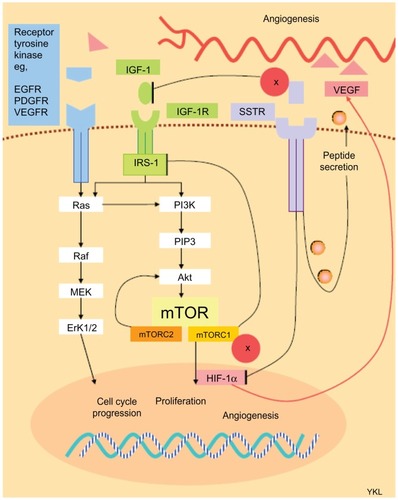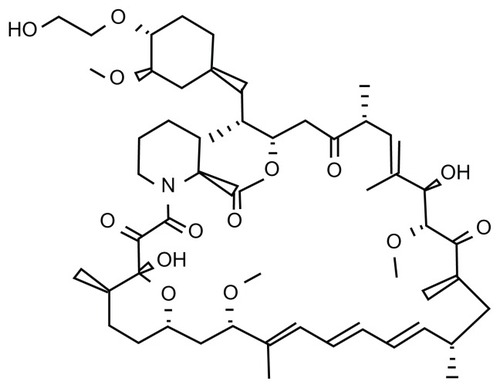Figures & data
Figure 1 Simplified diagram illustrating the mammalian target of rapamycin complex and mechanism of mammalian target of rapamycin inhibition by rapamycin.
Abbreviations: 4EBP1, eukaryotic translation initiation factor 4E binding protein-1; FR, FKBP12-rapamycin; FRB, FKBP12-rapamycin binding; mLST8, target of rapamycin complex subunit LST8; mSin1, mitogen-activated protein kinase-associated protein-1; mTOR, mammalian target of rapamycin; mTORC1, mammalian target of rapamycin complex-1; mTORC2, mammalian target of rapamycin complex-2; raptor, regulatory-associated protein of mammalian target of rapamycin; rictor, rapamycin-insensitive companion of mammalian target of rapamycin; S6K1, ribosomal protein S6 kinase-1.

Figure 3 Simplified diagram of the signaling network between surface receptors and intracellular pathways involved in tumor progression and angiogenesis in pancreatic neuroendocrine tumors, and interaction with mammalian target of rapamycin inhibition and somatostatin analog therapy.
Abbreviations: EGFR, epidermal growth factor receptor; ERK1/2, extracellular signal-regulated protein kinase 1/2; HIF-1α, hypoxia-inducible factor-1α; IGF-1 insulin-like growth factor-1; IGF-1R, insulin-like growth factor-1 receptor; IRS-1, insulin receptor substrate-1; MEK, mitogen-activated protein kinase kinase; mTOR, mammalian target of rapamycin; MTORC1, mammalian target of rapamycin complex-1; mTORC2, mammalian target of rapamycin complex-2; PDGFR, platelet-derived growth factor receptor; PI3K, phosphatidylinositol 3-kinase; PIP3, phosphatidylinositol (3,4,5)-triphosphate; SSTR, somatostatin receptor; VEGF, vascular endothelial growth factor; VEGFR, vascular endothelial growth factor receptor.

Table 1 Summary of neuroendocrine tumor clinical trials using mammalian target of rapamycin inhibitors
